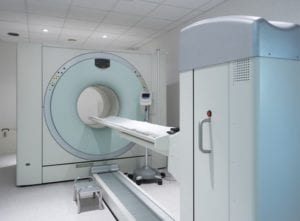Talc Pleurodesis Patients Need Alternate PET/CT Scan for Mesothelioma
 Certain patients may get more benefit out of an alternate type of PET/CT scan for mesothelioma.
Certain patients may get more benefit out of an alternate type of PET/CT scan for mesothelioma.
Positron emission tomography (PET) is a common tool for diagnosing mesothelioma. It is also used to monitor the effectiveness of mesothelioma treatments.
Doctors often combine PET with computed tomography (CT) for an even clearer picture of mesothelioma progression.
Typically, a PET/CT scan for mesothelioma involves injection of a tracer called FDG (fluorodeoxyglucose). But it turns out that PET/CT scans with this tracer do not work well for all mesothelioma patients.
A new Japanese study suggests that mesothelioma patients who have had a procedure called talc pleurodesis should consider a different kind of PET/CT scan instead.
How Does Talc Pleurodesis Impact PET/CT Scan for Mesothelioma?
Talc pleurodesis is one method for dealing with a common mesothelioma side effect called pleural effusion.
Mesothelioma patients with pleural effusion have a buildup of fluid in the space around the lungs.
As fluid builds up, it can compress the lungs, making it harder and harder for patients to get a deep breath. Talc pleurodesis involves filling in the space around the lungs with a talc solution so that fluid can no longer collect there.
But talc pleurodesis can make it harder for doctors to use an FDG PET/CT scan for mesothelioma diagnosis and monitoring. The FDG tends to collect in inflamed areas and produce false positive results.
This kind of PET/CT scan for mesothelioma can make it look like there are new tumors when there are no new tumors.
Choline PET/CT Scan for Mesothelioma May Work Better
To get around the problem of false positives with FDG PET/CT, the Japanese researchers tested a different kind of PET/CT scan for mesothelioma.
The alternate method uses a tracer called Choline C-11 instead of FDG. Inflamed or hardened areas in the pleura do not tend to absorb very much Choline.
As a result, a Choline PET/CT scan for mesothelioma is less likely to produce a false positive result.
The Japanese team used the alternative method in two mesothelioma patients after talc pleurodesis and neoadjuvant chemotherapy (NAC).
“Post-NAC 11C-choline PET/CT showed mild choline uptake of pleural talc deposit, which did not interfere with the post-chemotherapy disease evaluation,” concludes the report.
The researchers suggest that Choline PET/CT for mesothelioma is a better choice for diagnosis and treatment monitoring in patients who have had talc pleurodesis.
Source:
Kitajima, K, “Fluorodeoxyglucose versus Choline Positron Emission Tomography/Computed Tomography Response Evaluation in Two Malignant Pleural Mesothelioma Patients Treated with Talc Pleurodesis and Neoadjuvant Chemotherapy”, November 2018, https://www.cureus.com/articles/16340





